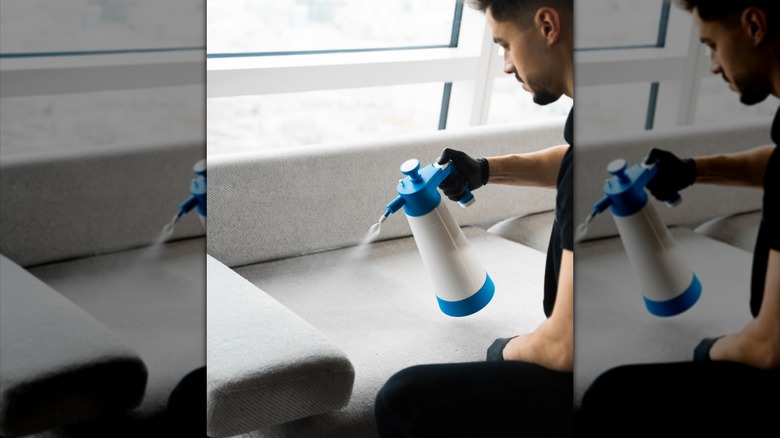Say Goodbye To Dust Mites Using An Easy Hydrogen Peroxide Hack
There are stylish ways to reduce allergens in your home; but if your allergies are flaring up, dust mites may have joined your household. These microscopic creatures thrive in warm, humid environments, making your bedding, carpets, and upholstered furniture the perfect residence for them. They also feed on human skin sheddings, and thus are reluctant to leave when they find a good host. While the bugs themselves aren't harmful, their droppings may trigger allergic reactions in your household. Regular cleaning, vacuuming, and washing your belongings at a high temperature can help, sometimes it takes a little extra effort to eradicate these unwelcome guests. Enter hydrogen peroxide, a useful chemical compound that is not only good at bleaching your laundry, but has powerful bug-busting properties too.
Hydrogen peroxide is a powerful disinfectant that breaks down proteins, DNA, membrane lipids, and other cell components. This oxidizing agent is lethal to dust mites, as it thus disintegrates them at a cellular level. When applied to surfaces where dust mites are likely to reside, it can help eliminate these pests while reducing the allergens they produce. So, you are treating the problem at its root cause, not just removing the droppings they produce. However, hydrogen peroxide can irritate the skin, and it's probably best to wear gloves or rinse your hands thoroughly after working with the chemical. However, if your hydrogen peroxide doesn't fizz while cleaning, it may be past its prime date and may no longer be effective.
Taking control of dust mites in your home
Your journey to a dust-mite-free home begins by mixing a solution of one part 3% hydrogen peroxide with one part water in a clean spray bottle. Because we're always looking for a twofer fix, you can add a few drops of essential oil, such as lavender or tea tree oil, both of which have a pleasant scent as well as anti-microbial properties. You want to target key areas in which the creepy crawlies are known to thrive. Lightly mist areas such as your mattress, pillows, couches, and carpets, paying special attention to crevices, seams, and folds where the dust mites can hide. The beauty of this treatment is that you don't need to drench the areas with the treatment, and peroxide evaporates quickly, leaving your surfaces dry.
After spraying the targeted areas, allow the hydrogen peroxide solution to sit on the fabric for about 15 to 20 minutes. This gives it enough time to break down the bugs and any allergens they may have left behind. Check that the areas you sprayed are dry, and then vacuum the surfaces thoroughly. By vacuuming the treated areas, you are removing the dead microscopic insects, allergens, and any remaining residue. If you still have a dust mite problem, repeat the treatment as needed. And if you have severe allergies, you may even consider treating your house frequently in order to remain mite-free. The best part, there are at least eight more hydrogen peroxide pest control hacks to try, so you can put your whole bottle to good use.

